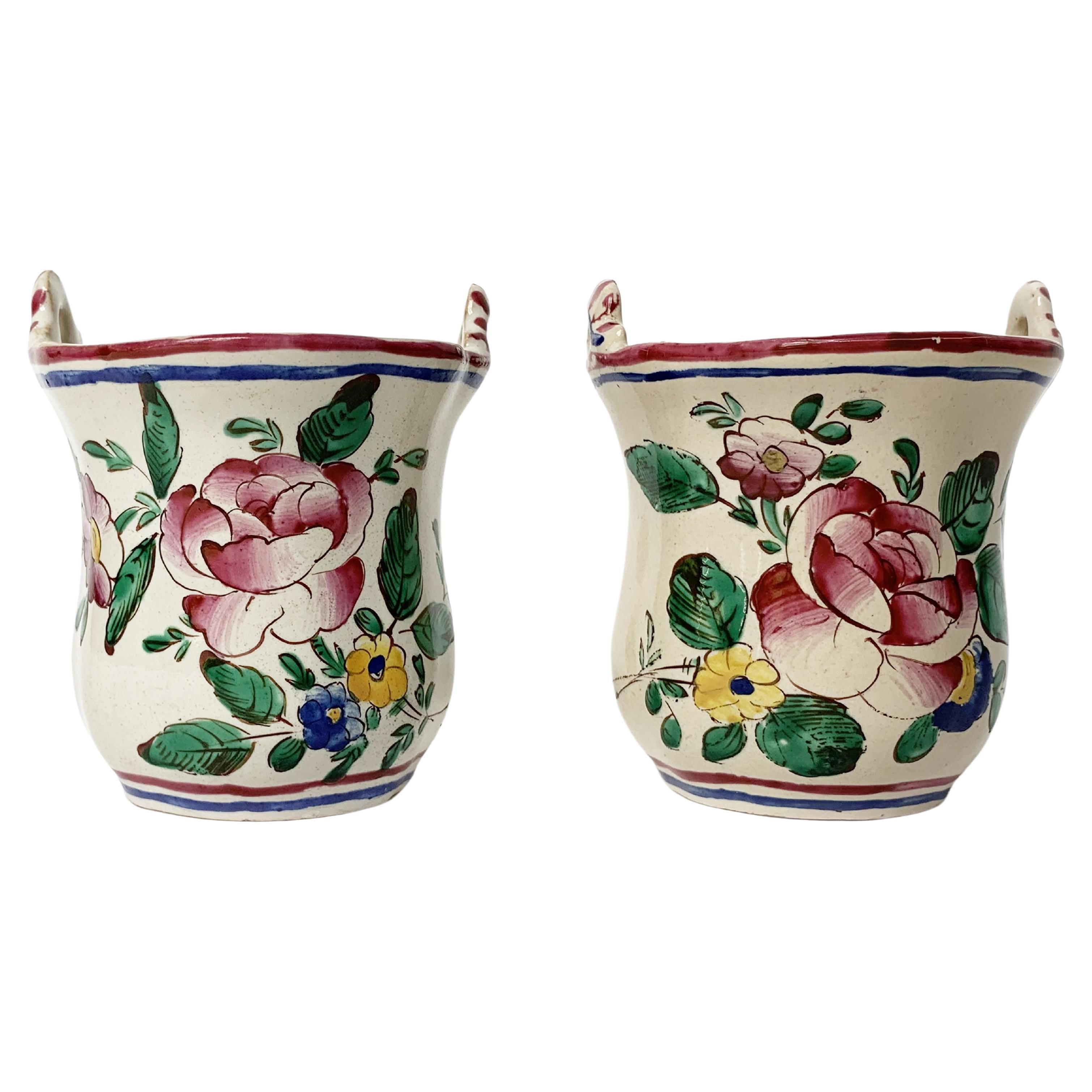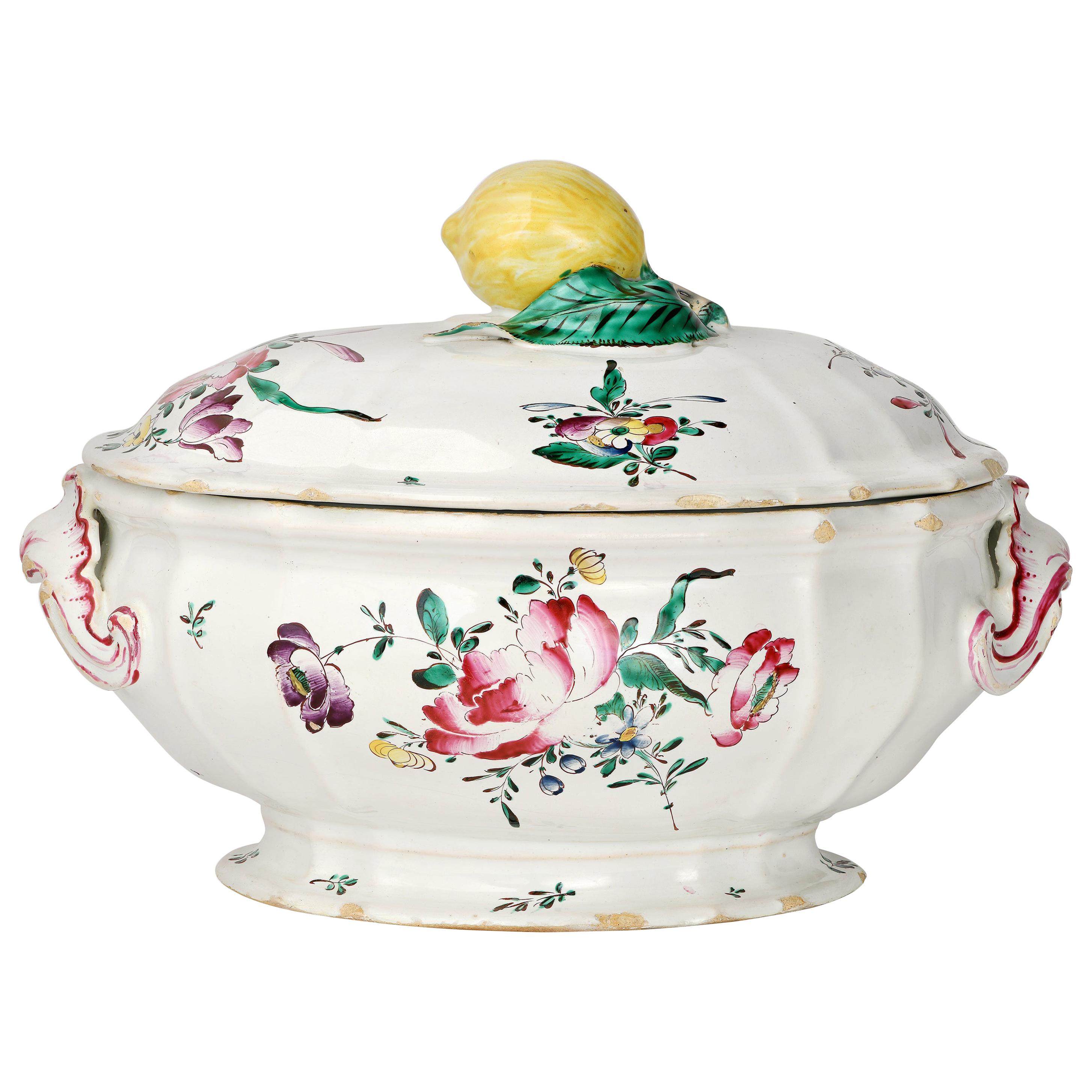Items Similar to Ancient Maiolica Dishes with flowers, Lombard Manufacture, 1770-1780 Circa
Video Loading
Want more images or videos?
Request additional images or videos from the seller
1 of 19
Ancient Maiolica Dishes with flowers, Lombard Manufacture, 1770-1780 Circa
About the Item
Assortment of dishes
Lombard manufacture
1770 – 1780 Circa
Maiolica polychrome decorated “a piccolo fuoco” (third fire).
Two large dishes: diameter 14.76 in (37.5 cm); weight 4.56 lb (2.07 kg).
Seven small dishes: diameter 9.44 in (24 cm); weight 5.73 lb (2.60 kg).
State of conservation: the dishes are intact, except for the presence in some specimens of a few slight cracks and small chips due to use.
The maiolica and porcelain factories of the eighteenth century belonged mainly to the great royal families or to the noble families who made the manufacture of ceramic works a motif of prestige. In Milan, under Maria Theresa of Austria, we instead witness a real opening to new industrialists who, by virtue of the privatization granted by the government, took on real business risks and gave life, even amid conflict between them, to flourishing factories. It was here that there was to be some of the most elegant and sought-after production of the moment, artworks which still remain objects of collection today.
In Milan in the 18th century, two majolica factories were active.
This assortment of dishes consists of two large dishes and seven smaller ones. All the pieces are fully enamelled and apod. The shape, while recalling the typical morphology of eighteenth-century Lodi and Milanese production, is distinguished by some details on the rim and the inner edge around the center.
The assortment is characterized by very precise naturalistic floral decoration with a rather striking bluish, almost emerald green, tone along with an abundant use of purple among other colours.
The decoration, referred to in contemporary inventories as “Strasbourg-style flowers”, is actually very similar to the French examples.
The ornamental design is focused on a main bouquet characterized by a dominant larger flower from which secondary branches with fewer flowers extend; in a more secluded position, complimentary elements, such as small roses and wildflowers appear.
The minor wildflowers - such as Myosotis or "Forget-me-nots", the buttercup, the cornflower, the bellflower - leave room for the main flowers, such as roses, carnations, precious tulips or even hibiscus flowers, which were introduced to Europe only in the eighteenth century: the decorative motif therefore favours specimens with a large corolla in full bloom.
This decorative style represented a strong point of the Lodi factory, which established itself thanks to the vivid nature of the colors made possible by the introduction of a new technique perfected by Paul Hannong in Strasbourg and which Antonio Ferretti introduced in Italy. This production process, called “piccolo fuoco” (third fire), allowed the use of a greater number of colors than in the past; in particular, the purple of Cassius, a red made from gold chloride, was introduced. Its use allowed for many more tones and shades, from pink to purple.
The aforementioned introduction in 1760 of the innovative “a piccolo fuoco” (third fire) technique enabled the expansion of the ornamental repertoire by offering Saxon-inspired floral themes and allowed the factory to commercially compete with the German porcelains, which had one of its most renowned offerings in the naturalistic Deutsche Blumen.
Antonio Ferretti understood and promoted this technique, as well as this decorative style, both of which were later adopted by the other factories in Lombardy with slightly different formal and decorative offerings. These versions, however, remained very close to the originals, as our nine dishes demonstrate. In fact, these can be placed among the Lodi production and represent precise examples of the ceramics which the Milanese manufacture of Pasquale Rubati placed on the market.
Bibliography
C. Baroni, Storia delle ceramiche nel Lodigiano, in Archivio storico per la città e i comuni del circondario e della diocesi di Lodi, XXXIV (1915), pp. 118, 124, 142; XXXV (1916), pp. 5-8;
C. Baroni, La maiolica antica di Lodi, in Archivio storico lombardo, LVIII (1931), pp. 453-455;
S. Levy, Maioliche settecentesche lombarde e venete, Milano 1962, pp. 17 sgg.;
A. Novasconi - S. Ferrari - S. Corvi, La ceramica lodigiana, Lodi 1964, ad Indicem; Maioliche di Lodi, Milano e Pavia (catal.), Milano 1964, p. 17;
O. Ferrari - G. Scavizzi, Maioliche italiane del Seicento e del Settecento, Milano 1965, pp. 26 sgg.;
M. Vitali, in Storia dell'arte ceramica, Bologna 1986, p. 251;
M. A. Zilocchi, in Settecento lombardo, Milano 1991, pp. 492-496;
M. L. Gelmini, in Maioliche lodigiane del '700 (cat. mostra Lodi), Milano 1995, pp. 31 ss., 45-47, 142-192;
R. Ausenda (a cura di), Musei e Gallerie di Milano. Museo d’Arti Applicate. Le ceramiche. Tomo secondo, Milano 2000, pp. 213-220;
Felice Ferrari, La ceramica di Lodi, Lodi 2003.
- Dimensions:Height: 1.19 in (3 cm)Diameter: 14.77 in (37.5 cm)
- Sold As:Set of 9
- Style:Rococo (Of the Period)
- Materials and Techniques:Maiolica,Glazed
- Place of Origin:
- Period:1770-1779
- Date of Manufacture:circa 1770-1780
- Condition:Minor losses. The dishes are intact, except for the presence in some specimens of a few slight cracks and small chips due to use.
- Seller Location:Milano, IT
- Reference Number:1stDibs: LU4352226957832
About the Seller
4.3
Vetted Seller
These experienced sellers undergo a comprehensive evaluation by our team of in-house experts.
Established in 1860
1stDibs seller since 2018
19 sales on 1stDibs
Typical response time: 6 hours
Associations
International Confederation of Art and Antique Dealers' Associations
- ShippingRetrieving quote...Ships From: Milano, Italy
- Return PolicyA return for this item may be initiated within 14 days of delivery.
More From This SellerView All
- Ancient Maiolica Cup, Rubati Manufacture, Milan, Circa 1770 - 1780By Pasquale RubatiLocated in Milano, ITSick cup Pasquale Rubati Manufacture Milan, Circa 1770 - 1780 Maiolica decorated in polychrome “a piccolo fuoco” (third fire) It measures: h 2.36 x 7.4 x 7.87 (h 6 x 19 x 20 cm) ...Category
Antique 1770s Italian Rococo Ceramics
MaterialsMaiolica
- Ancient Italian Maiolica Tureen, Rubati Manufacture, Milan, circa 1770-1780By Pasquale RubatiLocated in Milano, ITMaiolica tureen Pasquale Rubati Manufacture Milan, circa 1770 - 1780 Maiolica polychrome decorated “a piccolo fuoco” (third fire). It measures 6.69 in x 11,02 x 8.26 (17 x 28 x ...Category
Antique 1770s Italian Rococo Ceramics
MaterialsMaiolica
- Small Maiolica Flower Pots, Ferretti Manufacture, Lodi, circa 1770-1780By Antonio FerrettiLocated in Milano, ITTwo maiolica flower pots Antonio Ferretti Manufacture Lodi, Circa 1770 - 1780 Maiolica polychrome decorated “a piccolo fuoco” (third fire) The...Category
Antique 1770s Italian Rococo Ceramics
MaterialsMaiolica
- Maiolica Italian Pitcher Ferretti Manufacture, Lodi Circa 1770 - 1780By Antonio FerrettiLocated in Milano, ITMaiolica pitcher Antonio Ferretti Manufacture Lodi, circa 1770-1780 Maiolica polychrome decorated “a piccolo fuoco” (third fire). It measures 8.66 x 8.66 x 4.33 in (22 x 22 x 11 ...Category
Antique 1770s Italian Rococo Ceramics
MaterialsMaiolica
- Ancient Pair of Italian Maiolica Dishes Milano, circa 1770By Felice ClericiLocated in Milano, ITTwo maiolica dishes, "Famille Rose" decoration Felice Clerici Factory Milan, 1770-1780 9.13 in (23.2 cm) each in diameter lb 1.32 (kg 0.6) State of conservation: perfect, except for...Category
Antique 1770s Italian Rococo Ceramics
MaterialsMaiolica
- Italian Maiolica Ancient Tureen, Lodi, 1770-1780By Antonio FerrettiLocated in Milano, ITMaiolica tureen Antonio Ferretti Manufacture Lodi, circa 1770-1780 Maiolica polychrome decorated “a piccolo fuoco” (third fire). It measures 9.05 x 12.59 x 9.05 in (23 x 32 x 23 cm) ...Category
Antique 1770s Italian Rococo Ceramics
MaterialsMaiolica
You May Also Like
- Early Wedgwood Neoclassical Creamware Dessert Dishes Made circa 1780By WedgwoodLocated in Fort Lauderdale, FLA set of four early Wedgwood creamware Neoclassical dessert dishes made circa 1780. Sir William Hamilton’s Collection of Etruscan, Greek and Roman an...Category
Antique Late 18th Century English Neoclassical Ceramics
MaterialsCreamware
- Creamware Pair of English Flower Holders, 18th Century circa 1780By Neale & Co.Located in Katonah, NYWHY WE LOVE IT: One of our absolute favorites! A pair of 18th-century creamware flower holders complete with stands and covers made in England by Neale & Co. was one of the finest 18...Category
Antique Late 18th Century English Neoclassical Vases
MaterialsCreamware
- Circa 1770 Delft Blue & White PlateLocated in Chapel Hill, NCCirca 1770 Delft blue & white plate. Central handled & footed basket vase overflowing with flowers, surrounded by alternating repetive floral vases & naturalistic motifs. Frits comme...Category
Antique 1770s Dutch Ceramics
MaterialsCeramic
- Antique English Creamware 18th Century Sweetmeat Platt Menage circa 1780-1790By Leeds PotteryLocated in Katonah, NYWe are thrilled to offer this fabulous large three-tiered 18th-century creamware platt menage, made circa 1780-90 in Staffordshire or Yorkshire, England. It is a rare and elegant ex...Category
Antique Late 18th Century English Rococo Centerpieces
MaterialsCreamware
- Late 18th Century Blue And White Glazed Faience Charger, circa 1770, DenmarkLocated in Haddonfield, NJA large Danish (or Northern German) faience charger from circa 1780 in blue and white flower decor. The decoration is inspired by, or actually exact copies of the contemporary Chine...Category
Antique Late 18th Century Danish Rococo Ceramics
MaterialsFaience
- English Old DishesLocated in Alessandria, PiemonteO/3008 - There are four dishes diameter 23 and two diameter 19 cm. The name is "Continental Views" by Copeland and Garrett, very famous in Europe. These dishes are suitable for maki...Category
Antique Mid-19th Century English Other Ceramics
MaterialsCeramic





